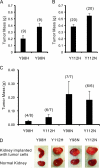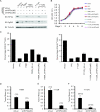Hypoxia-inducible factor linked to differential kidney cancer risk seen with type 2A and type 2B VHL mutations
- PMID: 17526729
- PMCID: PMC1952077
- DOI: 10.1128/MCB.00282-07
Hypoxia-inducible factor linked to differential kidney cancer risk seen with type 2A and type 2B VHL mutations
Abstract
Clear cell carcinoma of the kidney is a major cause of mortality in patients with von Hippel-Lindau (VHL) disease, which is caused by germ line mutations that inactivate the VHL tumor suppressor gene. Biallelic VHL inactivation, due to mutations or hypermethylation, is also common in sporadic clear cell renal carcinomas. The VHL gene product, pVHL, is part of a ubiquitin ligase complex that targets the alpha subunits of the heterodimeric transcription factor hypoxia-inducible factor (HIF) for destruction under well-oxygenated conditions. All VHL mutations linked to classical VHL disease compromise this pVHL function although some missense mutations result in a low risk of kidney cancer (type 2A VHL disease) while others result in a high risk (type 2B VHL disease). We found that type 2A mutants were less defective than type 2B mutants when reintroduced into VHL-/- renal carcinoma cells with respect to HIF regulation. A stabilized version of HIF2alpha promoted tumor growth by VHL-/- cells engineered to produce type 2A mutants, while knock-down of HIF2alpha in cells producing type 2B mutants had the opposite effect. Therefore, quantitative differences with respect to HIF deregulation are sufficient to account for the differential risks of kidney cancer linked to VHL mutations.
Figures






Similar articles
-
Renal cell carcinoma- and pheochromocytoma-specific altered gene expression profiles in VHL mutant clones.Oncol Rep. 2005 Jun;13(6):1033-41. Oncol Rep. 2005. PMID: 15870918
-
Up-regulation of hypoxia-inducible factors HIF-1alpha and HIF-2alpha under normoxic conditions in renal carcinoma cells by von Hippel-Lindau tumor suppressor gene loss of function.Oncogene. 2000 Nov 16;19(48):5435-43. doi: 10.1038/sj.onc.1203938. Oncogene. 2000. PMID: 11114720
-
Renal cell carcinoma risk in type 2 von Hippel-Lindau disease correlates with defects in pVHL stability and HIF-1alpha interactions.Oncogene. 2006 Jan 19;25(3):370-7. doi: 10.1038/sj.onc.1209062. Oncogene. 2006. PMID: 16261165
-
The von Hippel-Lindau tumor suppressor gene and kidney cancer.Clin Cancer Res. 2004 Sep 15;10(18 Pt 2):6290S-5S. doi: 10.1158/1078-0432.CCR-sup-040025. Clin Cancer Res. 2004. PMID: 15448019 Review.
-
The von Hippel-Lindau tumor suppressor protein and clear cell renal carcinoma.Clin Cancer Res. 2007 Jan 15;13(2 Pt 2):680s-684s. doi: 10.1158/1078-0432.CCR-06-1865. Clin Cancer Res. 2007. PMID: 17255293 Review.
Cited by
-
Molecular Dynamics Reveals Altered Interactions between Belzutifan and HIF-2 with Natural Variant G323E or Proximal Phosphorylation at T324.ACS Omega. 2024 Aug 26;9(36):37843-37855. doi: 10.1021/acsomega.4c03777. eCollection 2024 Sep 10. ACS Omega. 2024. PMID: 39281922 Free PMC article.
-
Kinase requirements in human cells: III. Altered kinase requirements in VHL-/- cancer cells detected in a pilot synthetic lethal screen.Proc Natl Acad Sci U S A. 2008 Oct 28;105(43):16484-9. doi: 10.1073/pnas.0806574105. Epub 2008 Oct 23. Proc Natl Acad Sci U S A. 2008. PMID: 18948595 Free PMC article.
-
The HIF and other quandaries in VHL disease.Oncogene. 2018 Jan 11;37(2):139-147. doi: 10.1038/onc.2017.338. Epub 2017 Sep 18. Oncogene. 2018. PMID: 28925400 Review.
-
Quantitative image analysis identifies pVHL as a key regulator of microtubule dynamic instability.J Cell Biol. 2010 Sep 20;190(6):991-1003. doi: 10.1083/jcb.201006059. J Cell Biol. 2010. PMID: 20855504 Free PMC article.
-
Genetic evidence of a precisely tuned dysregulation in the hypoxia signaling pathway during oncogenesis.Cancer Res. 2014 Nov 15;74(22):6554-64. doi: 10.1158/0008-5472.CAN-14-1161. Epub 2014 Nov 4. Cancer Res. 2014. PMID: 25371412 Free PMC article.
References
-
- An, Z., P. Jiang, X. Wang, A. R. Moossa, and R. M. Hoffman. 1999. Development of a high metastatic orthotopic model of human renal cell carcinoma in nude mice: benefits of fragment implantation compared to cell-suspension injection. Clin. Exp. Metastasis 17:265-270. - PubMed
-
- Appelhoff, R. J., Y. M. Tian, R. R. Raval, H. Turley, A. L. Harris, C. W. Pugh, P. J. Ratcliffe, and J. M. Gleadle. 2004. Differential function of the prolyl hydroxylases PHD1, PHD2, and PHD3 in the regulation of hypoxia-inducible factor. J. Biol. Chem. 279:38458-38465. - PubMed
-
- Aprelikova, O., G. V. Chandramouli, M. Wood, J. R. Vasselli, J. Riss, J. K. Maranchie, W. M. Linehan, and J. C. Barrett. 2004. Regulation of HIF prolyl hydroxylases by hypoxia-inducible factors. J. Cell Biochem. 92:491-501. - PubMed
-
- Bruick, R. K., and S. L. McKnight. 2001. A conserved family of prolyl-4-hydroxylases that modify HIF. Science 294:1337-1340. - PubMed
Publication types
MeSH terms
Substances
LinkOut - more resources
Full Text Sources
Other Literature Sources
Medical
Research Materials
